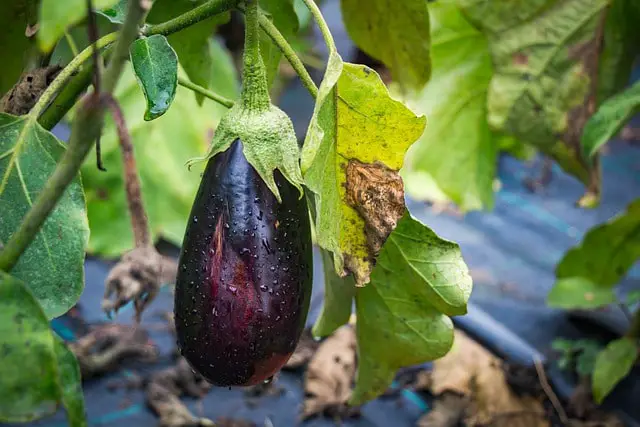A common ingredient in several cuisines all over the world, eggplant is a versatile vegetable. On the other hand, eggplant plants frequently experience yellowing leaves. Several things, including pests, illness, or environmental stress, can contribute to this. The causes of eggplant leaves becoming yellow will be discussed in this blog post, along with advice on how to avoid and resolve the problem.

The Eggplant Is Not Getting Enough Water
A lack of moisture is a frequent reason for yellowing leaves. When your Eggplant is not receiving enough water, its leaves will begin to droop in an effort to reduce water loss through transpiration. This is a way for the plant to conserve water. As the leaves prepare to fall off, they will turn yellow.
To determine if your plant is dry, you can check the soil by sticking your finger into it. If it is dry, it is important to establish a consistent watering schedule. Additional indicators that your plant is not receiving enough water include curled, drooping, or brittle-appearing leaves. You should water your Eggplant 1-2 inches per week.
The Dangers of Overwatering Your Eggplant
Overwatering your eggplants can be a common mistake, but it can have dire consequences for the health of your plants. Yellowing leaves can be a sign of waterlogged roots, which can lead to root rot and eventually kill your eggplants. To avoid this, make sure to check the soil moisture before watering and only water when the top inch of soil is dry. This will allow the roots to breathe and the plants to thrive, resulting in bountiful eggplants for your next harvest.
Nutrient Deficiency in the Eggplant
Deficiencies of nitrogen, potassium, magnesium, and iron could be responsible for the yellow leaves on your Eggplant. The most notable culprits as far as deficiency goes are nitrogen, potassium, magnesium, and iron. Deficits manifest themselves as chlorosis, yellowing of the leaves around their veins. This gives them a distinct appearance, making them easier to diagnose.
The soil will need better-balanced fertilizer or some good, old-fashioned fertilizer to address nutrient deficiencies. A nutrient may be inhibited from being absorbed if there is too much of it. It is important to keep everything in balance.
How Lack of Light Can Harm Your Eggplant
Plants will not produce enough chlorophyll if they do not receive enough light. Eggplants will suffer from yellowing leaves and poor health as a result. The light should be adequate for your plants, but not too much or too direct, depending on the type of plant.
The Eggplant needs at least 6 to 8 hours of direct sunlight per day. Organic soil with a high organic matter content is best for growing eggplants.
Your Eggplant Is Getting Too Much Light
Despite the fact that your Eggplant needs light to survive, there is such a thing as too much light. Sunlight that is too bright or excessive will not benefit your plants but instead cause them to overheat and get sunburned and leaves turn yellow.
Consequences of Improper Soil pH for Your Eggplant
It is the pH of the soil that determines the preference of any plant, and it ranges anywhere between 1-14, usually somewhere in the middle. The soil’s acidity or alkalinity can cause discomfort if it is too alkaline at 14. It is possible that the roots of the plant might even have difficulty absorbing the necessary nutrients from the soil. The yellowing of a plant’s leaves can be attributed to this factor.
Eggplants prefer a soil pH in the range of 5.5 to 6.5, so it is important to monitor the pH of the soil for optimal growth. Additionally, adding organic matter like compost can help to maintain a favorable soil pH for eggplants. You can test the pH of your soil with a pH tester you can purchase online or at a store. Yellow leaves are unlikely to appear if pH is within the correct range. You might just be able to balance it out properly if it’s too acidic or too alkaline.
Dealing With Pests and Disease On Your Eggplant
Pests are usually responsible for yellowing leaves on your Eggplant, so you can easily spot them. It is common for yellow spots to appear around bite marks and bullet marks on plant leaves. It is possible to see yellowing foliage, as well as the pest itself if you look closely. In general, aphids, whiteflies, scaly bugs, spider mites, and thrips are the most common pests. There are numerous species of winged bugs, as well as those that look like scales, fluff, or tiny winged insects. A simple pesticide will usually solve most pest problems.
Is It Possible for Yellowing leaves To Turn Green Again?
While it’s unlikely that yellow leaves will revert back to their vibrant green color, there’s still hope for your Eggplant. By identifying the cause of the yellowing and taking action to address it, you can prevent the spread of other leaves. And with a quick pruning of the yellowed leaves, your Eggplant will have the opportunity for a fresh start and new growth. Don’t let a few yellow leaves signify the end for your plants, take action and enjoy lush greenery once again.
Frequently Asked Questions About The Eggplant
What is eggplant?
Eggplant is a type of plant in the nightshade family with a spongy, edible, purple, or white fruit.
How do you prepare eggplant?
Eggplant can be cooked in a variety of ways, including baking, frying, and grilling. It is often served as an ingredient in a variety of dishes, such as ratatouille, moussaka, and baba ghanoush.
Is eggplant a good source of nutrition?
Yes, eggplant is a good source of dietary fiber, vitamin B6, vitamin C, magnesium, and potassium. It is also low in calories and fat.
What are some tips for selecting eggplant?
Look for eggplant that is firm and heavy for its size, with smooth, unblemished skin. Avoid eggplants with soft spots or wrinkles, as these are signs of age.”
